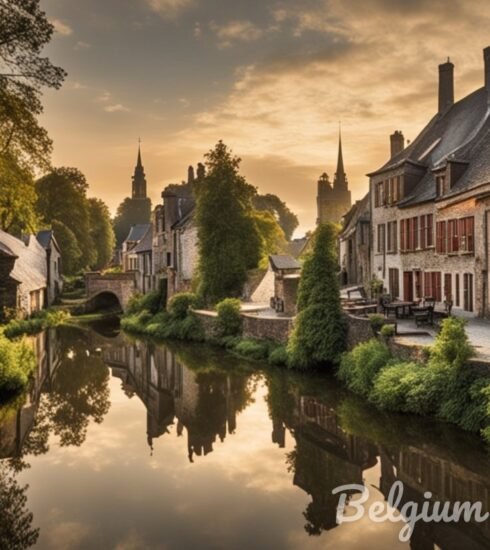Unveiling Belgian Ruins Stories: Whispers of the Ancients
Whispers of the Ancients: Untold Stories from Belgium’s Forgotten Ruins
In the heart of Europe lies Belgium, a country with a rich tapestry of history woven into its landscapes and architecture. Among the peacetime fortresses and medieval towns, there exist ruins that breathe secrets of distant times, echoing the whispers of the ancients. These forgotten marvels, buried beneath modernity, hold stories yearning to be told.
Introduction to Belgium’s Forgotten Ruins
Belgium, renowned for its chocolates, beer, and medieval town centers, also harbors a mystical world left in the shadows. These historic ruins serve as silent witnesses to the rise and fall of empires, great catastrophes, and the ebb and flow of civilization.
Before delving into the details, familiarize yourself with some enigmatic landmarks and Belgian legends that lay the groundwork for understanding these hidden gems.
The Enigmatic Castle of Vêves
Perched upon a rocky outcrop, the Castle of Vêves stands as one of the most enchanting ruins in Belgium. Its history dates back to the 7th century. Once a mighty fortress, today, it is a gateway to the past, offering visitors a glimpse into the medieval era with its fairy-tale turrets and fortified walls. Key points include:
- Established: 7th century
- Features: Stunning medieval architecture, fortified walls
- Significance: Served as a strategic military outpost
Exploration of this site reveals not only architectural triumphs but also the socio-political strategy of the times. For those fascinated by medieval history, the Castle of Vêves stands as a testament to the ingenuity and fortitude of its builders.

The Mysterious Ruins of Villers Abbey
The Ruins of Villers Abbey serve as a haunting reminder of Belgium’s complex religious history. Founded in the 12th century by Cistercian monks, this abbey once thrived as a center of spirituality and agriculture. Today, it lies in picturesque disarray, an echo of its glorious past.
The Grand History of Villers Abbey
At its peak, Villers Abbey was a hub of religious activity, housing over a hundred monks and numerous lay brothers. The abbey’s detailed history includes times of great prosperity followed by periods of decline, largely due to wars and fluctuating royal favor. Significant aspects include:
- Founded: 12th century
- Peak: 13th to 14th centuries
- Destruction: During the French Revolution
In present times, the abbey invites spiritual seekers and history enthusiasts alike, providing a realm where both stand in awe of the whispers of the past. The remnants of its cloisters and gardens continue to intrigue and inspire.
The Legend of Monschau Castle
Nestled in the majestic Ardennes hills lies Monschau Castle, a site enveloped in legend and mystery. Known colloquially as the Castle of Ghosts, Monschau holds a variety of age-old stories about its specters and unexplained phenomena.
Paranormal Attractions of Monschau
Despite being in ruins, Monschau Castle attracts visitors keen on experiencing its haunting ambiance. Highlights include:

- Legends: Specters roaming the halls
- Visitor Experience: Popularity with ghost hunters and thrill-seekers
- Historical Significance: Once a seat of power during medieval times
Although mostly uninhabited, the castle continuously fascinates those interested in paranormal phenomena and medieval history, linking Belgium’s mythical past with contemporary curiosity.
The Architectural Brilliance of Grand Hornu
Grand Hornu isn’t merely an industrial relic; it symbolizes the architectural innovation of the early 19th century. Though often overshadowed by history’s grander narratives, it plays a vital role in the story of Belgium’s industrial revolution.
The Industrial Heritage of Grand Hornu
Grand Hornu represents a significant chapter in Belgium’s industrial growth and urban planning evolution. Key highlights include:
- Era: Built in the early 19th century
- Builder: Henri De Gorge, a visionary industrialist
- Legacy: An important industrial hub transformed into a cultural center
Now a UNESCO World Heritage Site, Grand Hornu continues to inspire architects, historians, and tourists who marvel at its blend of functionality and aesthetic entrancement.

Exploring Belgium’s Ruins: A Walk through Time
Belgium’s ruins narrate stories of conquest, religion, and commerce, intertwining past glories with modern curiosity. From the industrial foresight of Grand Hornu to the ethereal beauty of Villers Abbey, these sites are portals into the realms of the past.
Guide for Modern Explorers
Explorers and history enthusiasts are advised to immerse themselves fully in the experience by:
- Researching each site’s history for deeper understanding
- Taking guided tours to learn from local scholars
- Considering the atmospheric influence of visiting sites at different times of the year
Whether through the legends of haunted castles or the architectural marvels of ancient fortifications, every ruin presents an opportunity to touch the past and live the stories that once were.
For those interested in detailed exploration, consider reading further at Enigmatic Landmarks and uncovering mythical lore at Belgian Legends. These resources provide deeper insights into the magic that imbues Belgium’s historic landscapes.
Conclusion: Preserving Belgium’s Past for Future Generations
The ruins of Belgium hold more than stories; they are lessons in resilience and a tribute to human creativity. As we continue to unveil the whispers of the ancients, these historic sites offer us the gift of perspective and wonder, serving as bridges between epochs. Through guided preservation and passionate exploration,{” “}future generations will inherit these tales, ensuring that the voices of the past continue to resonate.






